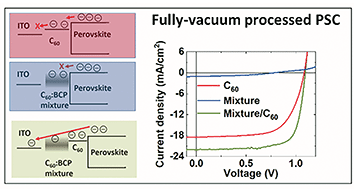Simple approach for an electron extraction layer in an all-vacuum processed n-i-p perovskite solar cell†
Abstract
Vacuum processing is considered to be a promising method allowing the scalable fabrication of perovskite solar cells (PSCs). In vacuum processed PSCs, the n-i-p structure employing organic charge transport layers is less common than the p-i-n structure due to limited options to achieve an efficient electron extraction layer (EEL) on indium tin oxide (ITO) with vacuum thermal evaporation. There are a number of specific applications where an n-i-p structure is required and therefore, it is of interest to have alternative solutions for the n-type contact in vacuum processed PSCs. In this work, we report an efficient vacuum deposited EEL using a mixture of conventional organic small molecules, C60 and bathocuproine (BCP). Incorporation of BCP into C60 does not result in conventional n-doping; however, we observed enhanced charge extraction, which significantly increased the power conversion efficiency (PCE) from 13.1% to 18.1% in all-vacuum processed PSCs. The C60:BCP mixed (co-sublimated) film most likely results in shifted energy levels leading to better alignment with the electrodes.

- This article is part of the themed collection: Perovskite solar cells – Topic Highlight


 Please wait while we load your content...
Please wait while we load your content...